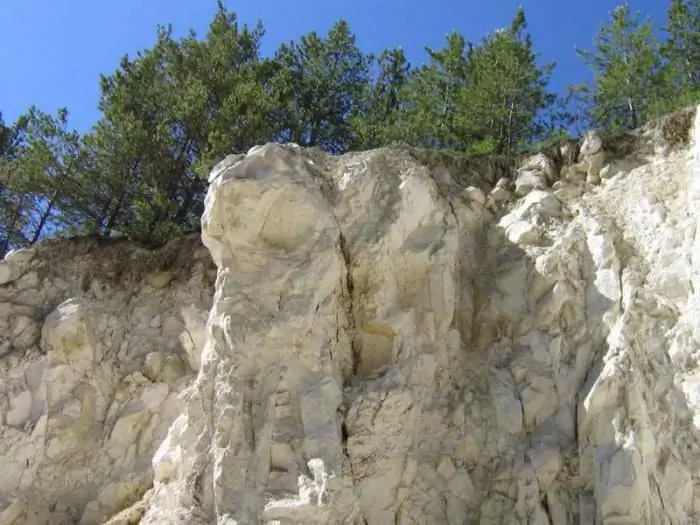- Author Harold Hamphrey [email protected].
- Public 2023-12-17 10:06.
- Last modified 2025-01-24 11:10.
The longest karst cave in the Ural Mountains is located in the north of the Perm Territory. Divya Cave is located on the western slope of the Northern Urals, in the valley of the Kolva River.

History
Divya Cave in Primorsky Krai is located in rather remote and hard-to-reach places, but despite this, it has been known to speleologists for more than two centuries. Its first scientific description was published in 1772. The author of this study was N. P. Rychkov. Almost half a century later (1821) the researcher of these places, V. N. Berkh, visited here. The plan of the cave was first drawn up in 1949 by S. Lukin. Later, other speleologists explored the Divya cave, discovering new sections of it.
Legend about the name of the cave
As we have already said, Divya Cave has been known since antiquity. It is shrouded in many traditions and legends, which are invariably associated with the beautiful Virgin, who once lived in a dense taiga forest near the Kolva River. On moonlit evenings, the beautiful Virgin appeared on the high river bank and spun. Her songs spread throughout the Ural expanses. But as soon as someone approached this place, she disappeared.

After some time, the young heroVetlan settled on the opposite bank, and the Virgin, once seeing him, was no longer able to retreat from the river, enchanted by his beauty. The young people fell in love with each other and decided to unite their hearts forever, but the high-water Colva opposed this. The maiden threw herself into the river to be next to her lover, but this was not destined to come true - the girl drowned. She reincarnated as a tall and beautiful mountain. Since then, the mountain has been called the Stone of Devi.
The bogatyr also turned to stone from grief, turning into an equally beautiful stone Vetlan, which is located on the opposite bank of the Kolva, a little downstream. From the name of the mountain got its name and the cave - Devya. Over time, this name was transformed and acquired its current sound - Divya.
Description
Divya Cave in the Urals is unique primarily because it was formed by an ancient stream that flowed from an aquifer that had already disappeared. It is for this reason that the cave has a peculiar structure. It is low, but in some areas it turns into impenetrable narrow manholes. In some places there are lifts and halls, the height of which reaches fifteen meters.

Basically, Divya Cave looks like an underground river bed, which it really is. Due to its unusual origin, the cave was included in the International List of Hydrological Monuments. Because of the moisture inside the cave, it seems that the water left it quite recently and is about to rush again in a huge stream.
How to get into the cave?
Entrance to it is in the arrayDivyego stone, in the forest at an altitude of more than ninety meters above the river. It is a small hole that resembles a hole. Its width is one and a half meters, and its height is only fifty centimeters. The only way to get into the cave is by crawling. This passage was named after Lukin, the first drafter of the cave map.

The cave is two-tiered, its cavities are elongated from east to west. With a total length of 10,100 meters, its depth is twenty-eight meters. The most extensive grottoes reach a length of fifty meters and a height of fifteen. Along with them, there are many narrow corridors that are quite difficult to overcome. Their names speak for themselves - Worm, Rolling Mill, etc.
Divya cave, the photo of which you can see in our article, amazes with its interior decoration: picturesque stalactites and stalagmites, sintered forms, huge stalagmite columns more than three and a half meters high, for example, in the Pillar Grotto, etc. d. Almost all types of crystalline and sinter calcite formations found in caves are collected in Divya cave.
The Skazka grotto is especially beautiful, which fully justifies its name. It has many stalagmites of the most bizarre shapes, and the walls are covered with yellow and white stains. Of interest to researchers is the statue of a woman, molded from clay. This is the "mistress of the cave." It is located in the Dalniy grotto. The air temperature in the cave is constant throughout the year. It can vary from +4 to +8°C.

Journey through these dungeons is an amazing adventure that does not tire even novice explorers at all. Divya cave is similar to the habitat of fairy gnomes. For experienced explorers, the passage through the cave is not difficult. For beginners, the main danger lies in the possibility of getting lost in countless moves.
Often, researchers spend the night right in the dungeons, choosing the driest place. Be quiet in the cave, especially in winter, as bats hibernate in it.

Lakes
There are several lakes in Divya. Even one of the grottoes is called Lake. The largest underground reservoir is located in the grotto of the Sun. About one hundred and eighty square meters is the area of his mirror. It stretched for ninety-six meters. The depth of the lake is one and a half meters.
Reviews and advice from experienced tourists
According to the tourists who visited this cave, they got a lot of vivid impressions from this extraordinary adventure. Anyone who wants to visit a cave on their own needs to be well prepared and have at least a basic cave experience. Although Divya is horizontal, it has a third category of difficulty. This is due to the length of the passages and the confusion of the labyrinths, which causes the risk of overwork, the possibility of getting lost, hypothermia, loss of light sources.
Plan your hike for at least three days. Print out a map of the cave, it will be difficult for an inexperienced person to navigate without it. The need for speci althere is no equipment when visiting the cave, the difficulties of exploring it arise only in the narrow labyrinths of passages, this is especially felt in its far part.
It will take you about eight hours to inspect the near part, about twenty in a large circle. In this case, an underground base camp should be organized.
Divya Cave, Perm Region: how to get there?
The nearest airport and railway station are in Perm. A regular bus follows from the city to the village of Nyrob. The journey will take you six and a half hours. You can get from the village to the cave by car. Better if it's an SUV. Then you should agree with the locals about the delivery to the cave and back on a motor boat. A well-packed path will lead you from the river to the cave. The ascent to the cave is not easy, but surmountable.






